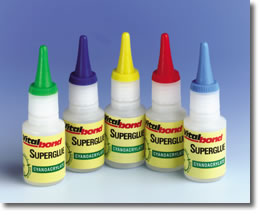
Adhesive

Cyanoacrylate adhesive (Superglue)
Image taken from http://www.gluelines.co.uk/vitalbond.htm
Simply, to act as an adhesive a liquid needs to wet two surfaces and set solid when required, while the resulting solid needs to give a sufficiently strong bond and stay put for as long as is necessary, in spite of everything the environment throws at it.
Why a liquid? Fans of Isaac Asimov's Foundation series will remember how the sales engineer demonstrates the value of 'atomics'. He slices a metal bar in two with an ultra-clean cut, presses the two fresh surfaces together and they are immediately rejoined, as if they had never been cut in the first place. Given an 'atomic' knife and a low enough partial pressure of oxygen that would probably work, however, the real world and in particular, real surfaces are not like that, and a liquid is needed to fill in the irregularities in the substrates.
Degrees of wetness
Which brings us on to wetting. A liquid will only wet a surface if its surface tension is lower than the so-called critical surface tension of the solid. A glance at Table 1 will show one of the reasons why polyethylene resists most adhesives, and why PTFE-coated saucepans can cope with such high-performance natural glues as burnt scrambled egg and dried porridge.
| Table 1. Surface tensions (ST) of selected liquids and critical surface tensions (CST) of selected solids at 20¢XC / mN m1 | ||||
| LIQUID |
ST |
SOLID |
CST |
|
| Mercury |
486 |
Aluminium |
500 |
|
| Water |
72 |
|||
| Epoxy resin |
47 |
Polymethylmethacrylate |
39 |
|
|
Cyanoacrylates (superglues) |
35-40 |
Polyethylene |
31 |
|
|
Acrylic and anaerobic adhesives |
25-40 |
|||
| Ethanol |
22 |
|||
| Pentane |
15 |
Polytetrafluoroethylene |
18 |
|
Once the liquid is in place we then need to turn it into a solid. Three methods of doing this should be obvious to chemists, and all are widely used in the adhesive industry:
Zips and chains
Looking at reactive adhesives, the type of chemical reaction that can be used is broad. Inorganic cements, for example, are often used to stick things together. But two types of polymerisation cover virtually the entire field. The first is the zipping-up of vinylic or related compounds, with a variety of initiating species (Box 1), where the rapid polymerisation of cyanoacrylates (superglues such as Super Attak from Loctite) by nucleophilic species is the best known example. The second most common is the chain-extension type of polymerisation (Box 2), typified by two-part epoxies (eg Araldite from Ciba Speciality Chemicals), polyurethanes or silicones.
Once polymerisation has taken place, what guarantees a strong bond? Well, the cohesive strength of the polymer clearly plays a part, but for reactive adhesives it is rarely the critical factor. Generally, of far greater significance is the adhesive strength of the polymersubstrate interface. Influencing this in turn are the cleanliness and roughness or smoothness of the surface to be bonded, and the presence or absence of reactive sites on the surface for the adhesive to latch on to. You can imagine that a sandwich of two smooth substrates and a layer of adhesive would be much easier to peel or slide apart than one where the substrate surfaces contain many microscopic blemishes for the adhesive to wick into indeed, a light abrasion is often recommended if you are trying to bond aluminium or stainless steel.
At one end of the spectrum, polyolefins have smooth unreactive surfaces, as well as being difficult to wet, and are therefore very difficult to bond without some sort of primer. At the other end, mild steel or acrylic resins accept virtually the entire range of reactive products. The choice of adhesive then depends on other factors: whether the joint will need to undergo considerable flexing (when an elastomeric product such as a polyurethane or a silicone would be appropriate); the range of environments the bond is likely to encounter; the desired speed of cure.
Art of adhesion
In between comes an assortment of substrates where selecting the adhesive is more of an art glass, aluminium and stainless steel, for example, or porous 'natural' substrates such as wood, leather and cardboard. Companies such as Loctite publish whole books on which product to use for particular applications.
Even when a good bond is formed, it's not the end of the story. Try sticking two pieces of glass together with a tube of standard superglue. You'll find that the initial bond is quite strong. However, after a few cycles in the dish-washer the pieces will fall apart again. Water can get in between the glass and the polycyanoacrylate, lifting the adhesive from the surface. It is for similar reasons that warm soapy water is suggested as one of the best treatments if you stick your fingers together with this type of product.
Other adhesivesubstrate combinations may be perfectly happy in water, but would suffer when exposed to more extreme environments under the bonnet of a car, perhaps, or after long-term exposure to sunlight. There's so much to remember that adhesive sales engineers generally have to specialise in a limited number of application areas.